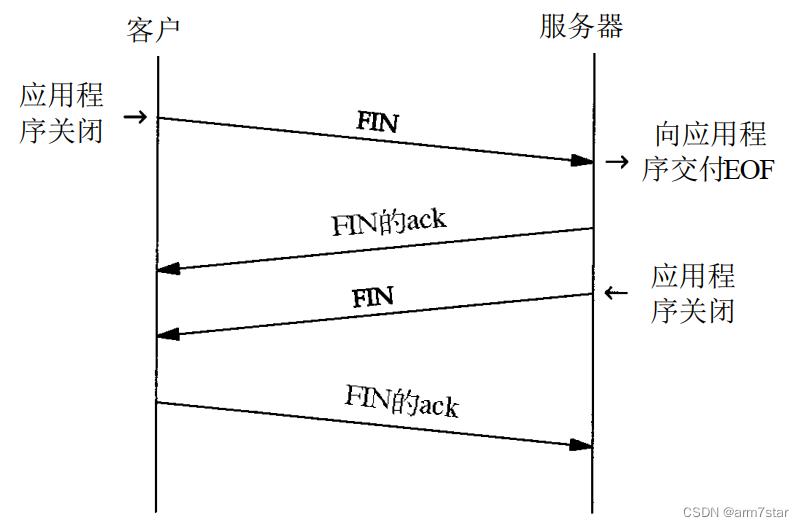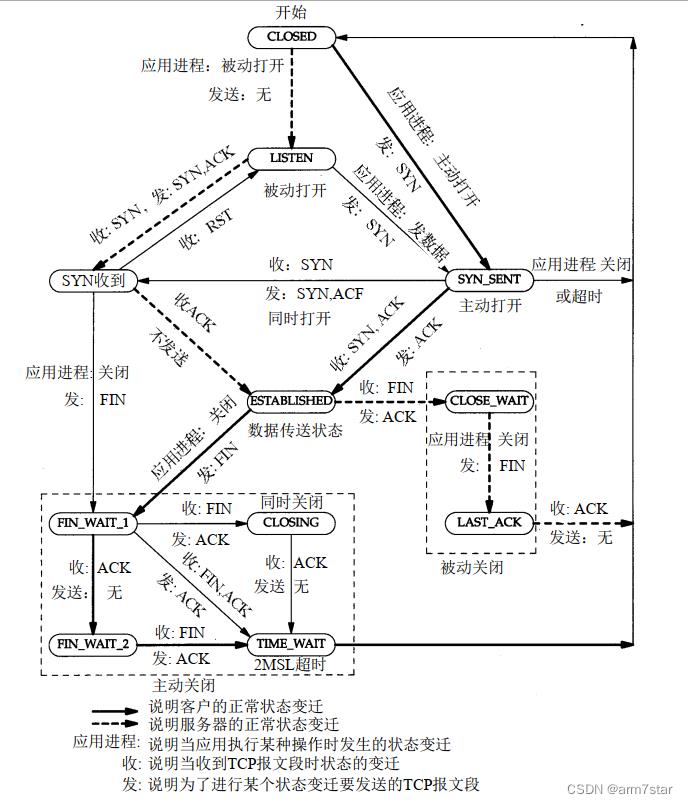linux网络协议栈源码分析 - 传输层(TCP连接的终止)
Posted arm7star
tags:
篇首语:本文由小常识网(cha138.com)小编为大家整理,主要介绍了linux网络协议栈源码分析 - 传输层(TCP连接的终止)相关的知识,希望对你有一定的参考价值。
1、连接终止过程(四处挥手)
1.1、四次挥手
《TCP/IP详解卷 1:协议》“图18-4 连接终止期间报文段的正常交换”如下:

1.2、tcp状态变迁图

2、close系统调用(第一次挥手)
客户端端调用close,发送FIN报文。
2.1、close系统调用
客户端调用close关闭socket,最终调用fput创建一个工作work来执行真正的关闭操作,fput函数代码如下:
void fput(struct file *file)
if (atomic_long_dec_and_test(&file->f_count))
struct task_struct *task = current;
if (likely(!in_interrupt() && !(task->flags & PF_KTHREAD)))
init_task_work(&file->f_u.fu_rcuhead, ____fput); // 初始化一个work,work的函数为____fput
if (!task_work_add(task, &file->f_u.fu_rcuhead, true)) // 添加work task
return; // 添加成功,返回
/*
* After this task has run exit_task_work(),
* task_work_add() will fail. Fall through to delayed
* fput to avoid leaking *file.
*/
if (llist_add(&file->f_u.fu_llist, &delayed_fput_list))
schedule_delayed_work(&delayed_fput_work, 1);
fput函数调用栈:

2.2、tcp_close关闭socket并发送FIN(第一次挥手)
fput系统调用添加一个work task之后,系统调用返回时处理挂起的work,调用____fput,最终调用tcp_close关闭socket。
tcp_close检查各种状态,删除接收队列数据,有数据未接收,直接关闭socket发送RST;正常关闭以及其他需要发送FIN报文的状态,发送FIN,调用sk_stream_wait_close等待关闭socket(某些状态不能立即关闭socket,所以要等待);正常关闭,收到FIN的ACK,进入TCP_FIN_WAIT2状态,c需要启动定时器,避免服务器长时间不调用close,TCP_FIN_WAIT2状态没有数据要发送,不能通过超时重传判断网络异常,另外TCP_FIN_WAIT2状态超时时间太短的话,会直接关闭socket,由timewait控制块替换socket控制块,所以,书籍上的tcp状态转移图与linux内核实现不完全相同,TCP_FIN_WAIT2超时时间够长的情况,就能基本完全匹配。
tcp_close函数代码如下:
void tcp_close(struct sock *sk, long timeout)
struct sk_buff *skb;
int data_was_unread = 0;
int state;
lock_sock(sk);
sk->sk_shutdown = SHUTDOWN_MASK; // 关闭读写(SHUTDOWN_MASK = RCV_SHUTDOWN | SEND_SHUTDOWN);读写关闭状态,如果使用epoll等待该socket的话,调用tcp_poll会返回POLLHUP!!!
if (sk->sk_state == TCP_LISTEN) // 关闭LISTEN的socket
tcp_set_state(sk, TCP_CLOSE); // 设置为CLOSE
/* Special case. */
inet_csk_listen_stop(sk); // 停止监听(具体参考机械工业出版社《Linux内核源码剖析:TCP/IP实现(下册)》"32.3 close传输接口层的实现: tcp_close()")
goto adjudge_to_death; // 跳转到adjudge_to_death
/* We need to flush the recv. buffs. We do this only on the
* descriptor close, not protocol-sourced closes, because the
* reader process may not have drained the data yet!
*/
while ((skb = __skb_dequeue(&sk->sk_receive_queue)) != NULL) // tcp接收队列有数据,则删除接收队列的数据
u32 len = TCP_SKB_CB(skb)->end_seq - TCP_SKB_CB(skb)->seq; // skb报文长度
if (TCP_SKB_CB(skb)->tcp_flags & TCPHDR_FIN) // FIN报文(FIN报文占一个序号,但是FIN报文没有实际数据)
len--; // 删除的数据减1(FIN序号不带数据)
data_was_unread += len; // 删除的没有读的数据总长度
__kfree_skb(skb); // 释放skb报文
sk_mem_reclaim(sk); // 回收缓存
/* If socket has been already reset (e.g. in tcp_reset()) - kill it. */
if (sk->sk_state == TCP_CLOSE)
goto adjudge_to_death;
/* As outlined in RFC 2525, section 2.17, we send a RST here because
* data was lost. To witness the awful effects of the old behavior of
* always doing a FIN, run an older 2.1.x kernel or 2.0.x, start a bulk
* GET in an FTP client, suspend the process, wait for the client to
* advertise a zero window, then kill -9 the FTP client, wheee...
* Note: timeout is always zero in such a case.
*/
if (unlikely(tcp_sk(sk)->repair))
sk->sk_prot->disconnect(sk, 0);
else if (data_was_unread) // 关闭socket的时候,有未接收的数据
/* Unread data was tossed, zap the connection. */
NET_INC_STATS_USER(sock_net(sk), LINUX_MIB_TCPABORTONCLOSE);
tcp_set_state(sk, TCP_CLOSE); // 直接设置为CLOSE状态
tcp_send_active_reset(sk, sk->sk_allocation); // 发送RST重置连接
else if (sock_flag(sk, SOCK_LINGER) && !sk->sk_lingertime)
/* Check zero linger _after_ checking for unread data. */
sk->sk_prot->disconnect(sk, 0);
NET_INC_STATS_USER(sock_net(sk), LINUX_MIB_TCPABORTONDATA);
else if (tcp_close_state(sk)) // 调用tcp_close_state,从当前状态转换到下一个状态(正常关闭情况下,进入TCP_FIN_WAIT1状态,TCP_FIN_WAIT1需要发送FIN)
/* We FIN if the application ate all the data before
* zapping the connection.
*/
/* RED-PEN. Formally speaking, we have broken TCP state
* machine. State transitions:
*
* TCP_ESTABLISHED -> TCP_FIN_WAIT1
* TCP_SYN_RECV -> TCP_FIN_WAIT1 (forget it, it's impossible)
* TCP_CLOSE_WAIT -> TCP_LAST_ACK
*
* are legal only when FIN has been sent (i.e. in window),
* rather than queued out of window. Purists blame.
*
* F.e. "RFC state" is ESTABLISHED,
* if Linux state is FIN-WAIT-1, but FIN is still not sent.
*
* The visible declinations are that sometimes
* we enter time-wait state, when it is not required really
* (harmless), do not send active resets, when they are
* required by specs (TCP_ESTABLISHED, TCP_CLOSE_WAIT, when
* they look as CLOSING or LAST_ACK for Linux)
* Probably, I missed some more holelets.
* --ANK
* XXX (TFO) - To start off we don't support SYN+ACK+FIN
* in a single packet! (May consider it later but will
* probably need API support or TCP_CORK SYN-ACK until
* data is written and socket is closed.)
*/
tcp_send_fin(sk); // 调用tcp_send_fin发送FIN报文(调用tcp_queue_skb将FIN报文缓存到发送队列(如果发送队列还有未确认的数据,那么需要等待其他数据发送完再发送FIN报文,FIN报文虽然不一定有数据(可以附加到最后一个带数据的报文),但是FIN可能丢失,FIN报文需要超时重传),调用__tcp_push_pending_frames发送挂起的报文)
sk_stream_wait_close(sk, timeout); // 等待socket关闭(查看sk_stream_closing函数,等待TCPF_FIN_WAIT1/TCPF_CLOSING/TCPF_LAST_ACK状态或者超时)
adjudge_to_death:
state = sk->sk_state;
sock_hold(sk);
sock_orphan(sk); // 设置套接口为孤儿套接口并且设置SOCK_DEAD标志
/* It is the last release_sock in its life. It will remove backlog. */
release_sock(sk); // 删除backlog队列并唤醒其他等待socket的线程
/* Now socket is owned by kernel and we acquire BH lock
to finish close. No need to check for user refs.
*/
local_bh_disable();
bh_lock_sock(sk);
WARN_ON(sock_owned_by_user(sk));
percpu_counter_inc(sk->sk_prot->orphan_count);
/* Have we already been destroyed by a softirq or backlog? */
if (state != TCP_CLOSE && sk->sk_state == TCP_CLOSE) // socket已经被关闭,跳转到out,不处理
goto out;
/* This is a (useful) BSD violating of the RFC. There is a
* problem with TCP as specified in that the other end could
* keep a socket open forever with no application left this end.
* We use a 1 minute timeout (about the same as BSD) then kill
* our end. If they send after that then tough - BUT: long enough
* that we won't make the old 4*rto = almost no time - whoops
* reset mistake.
*
* Nope, it was not mistake. It is really desired behaviour
* f.e. on http servers, when such sockets are useless, but
* consume significant resources. Let's do it with special
* linger2 option. --ANK
*/
if (sk->sk_state == TCP_FIN_WAIT2) // TCP_FIN_WAIT2状态(已收到FIN的ACK,等待服务器调用close发送FIN)
struct tcp_sock *tp = tcp_sk(sk);
if (tp->linger2 < 0)
tcp_set_state(sk, TCP_CLOSE);
tcp_send_active_reset(sk, GFP_ATOMIC);
NET_INC_STATS_BH(sock_net(sk),
LINUX_MIB_TCPABORTONLINGER);
else
const int tmo = tcp_fin_time(sk); // TCP_FIN_WAIT2状态超时时间(本地已经关闭了读写,已经没有任何数据要发送了,如果不启动超时定时器并且服务器不调用close的话,那么TCP_FIN_WAIT2将不会结束)
if (tmo > TCP_TIMEWAIT_LEN) // 大于60秒,使用TCP_FIN_WAIT2定时器处理TCP_FIN_WAIT2状态,超时之后,tcp_keepalive_timer直接发送RST然后强制关闭socket
inet_csk_reset_keepalive_timer(sk,
tmo - TCP_TIMEWAIT_LEN);
else // 小于等于60秒
tcp_time_wait(sk, TCP_FIN_WAIT2, tmo); // 调用tcp_time_wait处理,由timewait控制块替代socket控制块(将timewait添加到哈希表,从哈希表删除sk,输入报文将由timewait控制块接收),调用tcp_done将sk状态设置为TCP_CLOSE状态,timewait控制块tw_state处于TCP_TIME_WAIT状态,启动超时定时器,超时之后调用tw_timer_handler释放timewait控制块
goto out;
if (sk->sk_state != TCP_CLOSE) // 未处于TCP_CLOSE状态(TCP_FIN_WAIT2等状态,或者等待超时了...)
sk_mem_reclaim(sk);
if (tcp_check_oom(sk, 0)) // 孤儿套接口、发送缓存等超限(具体参考机械工业出版社《Linux内核源码剖析:TCP/IP实现(下册)》P999),不等待服务器,强制关闭socket、发送RST给服务器
tcp_set_state(sk, TCP_CLOSE); // 关闭socket
tcp_send_active_reset(sk, GFP_ATOMIC); // 发送RST
NET_INC_STATS_BH(sock_net(sk),
LINUX_MIB_TCPABORTONMEMORY);
if (sk->sk_state == TCP_CLOSE)
struct request_sock *req = tcp_sk(sk)->fastopen_rsk;
/* We could get here with a non-NULL req if the socket is
* aborted (e.g., closed with unread data) before 3WHS
* finishes.
*/
if (req)
reqsk_fastopen_remove(sk, req, false);
inet_csk_destroy_sock(sk);
/* Otherwise, socket is reprieved until protocol close. */
out:
bh_unlock_sock(sk);
local_bh_enable();
sock_put(sk);
tcp_send_fin函数调用栈:


(调试过程,可以修改/proc/sys/net/ipv4/tcp_fin_timeout,增加tcp_fin_timeout,避免TCP_FIN_WAIT2状态直接关闭socket!!!)
3、服务器收到FIN发送ACK(第二次挥手)
3.1、服务器端收到处理FIN报文
服务器在TCP_ESTABLISHED状态下收到报文调用tcp_rcv_established处理收到的报文,如果收到预期的报文(非乱序的报文),那么调用tcp_data_queue将数据接收到接收队列,并检查该报文是否有FIN标志,如果有,就调用tcp_fin关闭接收(客户端已经关闭了发送,所以客户端也不应该再接收数据了)、状态迁移到TCP_CLOSE_WAIT、删除乱序的数据(FIN之后的乱序数据不接收,这些乱序数据基本上应该就是错误的数据)并唤醒其他等待socket的线程。
tcp_fin函数代码实现:
static void tcp_fin(struct sock *sk)
struct tcp_sock *tp = tcp_sk(sk);
inet_csk_schedule_ack(sk);
sk->sk_shutdown |= RCV_SHUTDOWN; // 关闭接收
sock_set_flag(sk, SOCK_DONE);
switch (sk->sk_state)
case TCP_SYN_RECV:
case TCP_ESTABLISHED:
/* Move to CLOSE_WAIT */
tcp_set_state(sk, TCP_CLOSE_WAIT); // 迁移到TCP_CLOSE_WAIT状态,等待调用close
inet_csk(sk)->icsk_ack.pingpong = 1;
break;
case TCP_CLOSE_WAIT:
case TCP_CLOSING:
/* Received a retransmission of the FIN, do
* nothing.
*/
break;
case TCP_LAST_ACK:
/* RFC793: Remain in the LAST-ACK state. */
break;
case TCP_FIN_WAIT1:
/* This case occurs when a simultaneous close
* happens, we must ack the received FIN and
* enter the CLOSING state.
*/
tcp_send_ack(sk);
tcp_set_state(sk, TCP_CLOSING);
break;
case TCP_FIN_WAIT2:
/* Received a FIN -- send ACK and enter TIME_WAIT. */
tcp_send_ack(sk);
tcp_time_wait(sk, TCP_TIME_WAIT, 0);
break;
default:
/* Only TCP_LISTEN and TCP_CLOSE are left, in these
* cases we should never reach this piece of code.
*/
pr_err("%s: Impossible, sk->sk_state=%d\\n",
__func__, sk->sk_state);
break;
/* It _is_ possible, that we have something out-of-order _after_ FIN.
* Probably, we should reset in this case. For now drop them.
*/
__skb_queue_purge(&tp->out_of_order_queue); // 删除乱序的队列
if (tcp_is_sack(tp))
tcp_sack_reset(&tp->rx_opt);
sk_mem_reclaim(sk);
if (!sock_flag(sk, SOCK_DEAD))
sk->sk_state_change(sk); // 调用sk_state_change(正常情况下,sk_state_change函数指针实际指向sock_def_wakeup函数,sk_state_change不是改变socket状态,而是socket状态改变之后的处理函数)
/* Do not send POLL_HUP for half duplex close. */
if (sk->sk_shutdown == SHUTDOWN_MASK ||
sk->sk_state == TCP_CLOSE) // 读写都关闭了或者socket已经关闭了,这种情况下不能读写
sk_wake_async(sk, SOCK_WAKE_WAITD, POLL_HUP); // 触发POLL_HUP事件
else
sk_wake_async(sk, SOCK_WAKE_WAITD, POLL_IN); // 半关闭状态(这里应该是只关闭了读),那么触发POLL_IN事件,socket关闭了读,触发读事件,读socket会返回对应的错误,根据对应的错误就知道socket已经关闭了
tcp_fin函数调用栈:

服务器端收到FIN的时候,只关闭了接收,还没关闭发送,服务器端调用tcp_data_snd_check检查是否有数据被确认接收,调用tcp_ack_snd_check检查并发送ACK。
tcp_send_ack函数调用栈:

3.2、客户端收到FIN的ACK
阻塞模式,客户端关闭等待socket的时候,收到报文之后,由"用户"处理报文,不在软中断处理;TCP_FIN_WAIT1处理报文的调用栈如下:

(注意上面的调用栈,接着调用close的函数继续执行,也就是软中断不处理报文)
客户端TCP_FIN_WAIT1状态收到FIN的ACK,迁移到TCP_FIN_WAIT2状态,并启动超时定时器。
tcp_rcv_state_process函数代码如下:
int tcp_rcv_state_process(struct sock *sk, struct sk_buff *skb)
struct tcp_sock *tp = tcp_sk(sk);
struct inet_connection_sock *icsk = inet_csk(sk);
const struct tcphdr *th = tcp_hdr(skb);
struct request_sock *req;
int queued = 0;
bool acceptable;
tp->rx_opt.saw_tstamp = 0;
switch (sk->sk_state)
case TCP_CLOSE:
goto discard;
case TCP_LISTEN:
if (th->ack)
return 1;
if (th->rst)
goto discard;
if (th->syn)
if (th->fin)
goto discard;
if (icsk->icsk_af_ops->conn_request(sk, skb) < 0)
return 1;
/* Now we have several options: In theory there is
* nothing else in the frame. KA9Q has an option to
* send data with the syn, BSD accepts data with the
* syn up to the [to be] advertised window and
* Solaris 2.1 gives you a protocol error. For now
* we just ignore it, that fits the spec precisely
* and avoids incompatibilities. It would be nice in
* future to drop through and process the data.
*
* Now that TTCP is starting to be used we ought to
* queue this data.
* But, this leaves one open to an easy denial of
* service attack, and SYN cookies can't defend
* against this problem. So, we drop the data
* in the interest of security over speed unless
* it's still in use.
*/
kfree_skb(skb);
return 0;
goto discard;
case TCP_SYN_SENT:
queued = tcp_rcv_synsent_state_process(sk, skb, th);
if (queued >= 0)
return queued;
/* Do step6 onward by hand. */
tcp_urg(sk, skb, th);
__kfree_skb(skb);
tcp_data_snd_check(sk);
return 0;
req = tp->fastopen_rsk;
if (req)
WARN_ON_ONCE(sk->sk_state != TCP_SYN_RECV &&
sk->sk_state != TCP_FIN_WAIT1);
if (!tcp_check_req(sk, skb, req, true))
goto discard;
if (!th->ack && !th->rst && !th->syn)
goto discard;
if (!tcp_validate_incoming(sk, skb, th, 0))
return 0;
/* step 5: check the ACK field */
acceptable = tcp_ack(sk, skb, FLAG_SLOWPATH |
FLAG_UPDATE_TS_RECENT) > 0;
switch (sk->sk_state)
case TCP_SYN_RECV:
if (!acceptable)
return 1;
if (!tp->srtt_us)
tcp_synack_rtt_meas(sk, req);
/* Once we leave TCP_SYN_RECV, we no longer need req
* so release it.
*/
if (req)
tp->total_retrans = req->num_retrans;
reqsk_fastopen_remove(sk, req, false);
else
/* Make sure socket is routed, for correct metrics. */
icsk->icsk_af_ops->rebuild_header(sk);
tcp_init_congestion_control(sk);
tcp_mtup_init(sk);
tp->copied_seq = tp->rcv_nxt;
tcp_init_buffer_space(sk);
smp_mb();
tcp_set_state(sk, TCP_ESTABLISHED);
sk->sk_state_change(sk);
/* Note, that this wakeup is only for marginal crossed SYN case.
* Passively open sockets are not waked up, because
* sk->sk_sleep == NULL and sk->sk_socket == NULL.
*/
if (sk->sk_socket)
sk_wake_async(sk, SOCK_WAKE_IO, POLL_OUT);
tp->snd_una = TCP_SKB_CB(skb)->ack_seq;
tp->snd_wnd = ntohs(th->window) << tp->rx_opt.snd_wscale;
tcp_init_wl(tp, TCP_SKB_CB(skb)->seq);
if (tp->rx_opt.tstamp_ok)
tp->advmss -= TCPOLEN_TSTAMP_ALIGNED;
if (req)
/* Re-arm the timer because data may have been sent out.
* This is similar to the regular data transmission case
* when new data has just been ack'ed.
*
* (TFO) - we could try to be more aggressive and
* retransmitting any data sooner based on when they
* are sent out.
*/
tcp_rearm_rto(sk);
else
tcp_init_metrics(sk);
tcp_update_pacing_rate(sk);
/* Prevent spurious tcp_cwnd_restart() on first data packet */
tp->lsndtime = tcp_time_stamp;
tcp_initialize_rcv_mss(sk);
tcp_fast_path_on(tp);
break;
case TCP_FIN_WAIT1: // TCP_FIN_WAIT1状态收到报文
struct dst_entry *dst;
int tmo;
/* If we enter the TCP_FIN_WAIT1 state and we are a
* Fast Open socket and this is the first acceptable
* ACK we have received, this would have acknowledged
* our SYNACK so stop the SYNACK timer.
*/
if (req)
/* Return RST if ack_seq is invalid.
* Note that RFC793 only says to generate a
* DUPACK for it but for TCP Fast Open it seems
* better to treat this case like TCP_SYN_RECV
* above.
*/
if (!acceptable)
return 1;
/* We no longer need the request sock. */
reqsk_fastopen_remove(sk, req, false);
tcp_rearm_rto(sk);
if (tp->snd_una != tp->write_seq) // TCP_FIN_WAIT1收到ACK不并一定是对FIN的确认,发送FIN的时候并没有检查发送队列,发送队列有数据的时候,FIN报文可能还在排队,FIN的序号应该是tp->write_seq - 1,如果FIN被确认,那么tp->snd_una就应该等于tp->write_seq(下一个发送的序号)
break; // FIN还没发送
tcp_set_state(sk, TCP_FIN_WAIT2); // tp->snd_una == tp->write_seq表示FIN已经被确认了,迁移到TCP_FIN_WAIT2状态
sk->sk_shutdown |= SEND_SHUTDOWN; // 关闭发送
dst = __sk_dst_get(sk);
if (dst)
dst_confirm(dst);
if (!sock_flag(sk, SOCK_DEAD))
/* Wake up lingering close() */
sk->sk_state_change(sk);
break;
if (tp->linger2 < 0 ||
(TCP_SKB_CB(skb)->end_seq != TCP_SKB_CB(skb)->seq &&
after(TCP_SKB_CB(skb)->end_seq - th->fin, tp->rcv_nxt)))
tcp_done(sk);
NET_INC_STATS_BH(sock_net(sk), LINUX_MIB_TCPABORTONDATA);
return 1;
tmo = tcp_fin_time(sk); // 计算TCP_FIN_WAIT2超时时间(与调用tcp_close一样)
if (tmo > TCP_TIMEWAIT_LEN)
inet_csk_reset_keepalive_timer(sk, tmo - TCP_TIMEWAIT_LEN);
else if (th->fin || sock_owned_by_user(sk))
/* Bad case. We could lose such FIN otherwise.
* It is not a big problem, but it looks confusing
* and not so rare event. We still can lose it now,
* if it spins in bh_lock_sock(), but it is really
* marginal case.
*/
inet_csk_reset_keepalive_timer(sk, tmo); // 与调用tcp_close一样
else
tcp_time_wait(sk, TCP_FIN_WAIT2, tmo); // 与调用tcp_close一样
goto discard;
break;
case TCP_CLOSING:
if (tp->snd_una == tp->write_seq)
tcp_time_wait(sk, TCP_TIME_WAIT, 0);
goto discard;
break;
case TCP_LAST_ACK:
if (tp->snd_una == tp->write_seq)
tcp_update_metrics(sk);
tcp_done(sk);
goto discard;
break;
/* step 6: check the URG bit */
tcp_urg(sk, skb, th);
/* step 7: process the segment text */
switch (sk->sk_state)
case TCP_CLOSE_WAIT:
case TCP_CLOSING:
case TCP_LAST_ACK:
if (!before(TCP_SKB_CB(skb)->seq, tp->rcv_nxt))
break;
case TCP_FIN_WAIT1:
case TCP_FIN_WAIT2:
/* RFC 793 says to queue data in these states,
* RFC 1122 says we MUST send a reset.
* BSD 4.4 also does reset.
*/
if (sk->sk_shutdown & RCV_SHUTDOWN)
if (TCP_SKB_CB(skb)->end_seq != TCP_SKB_CB(skb)->seq &&
after(TCP_SKB_CB(skb)->end_seq - th->fin, tp->rcv_nxt))
NET_INC_STATS_BH(sock_net(sk), LINUX_MIB_TCPABORTONDATA);
tcp_reset(sk);
return 1;
/* Fall through */
case TCP_ESTABLISHED:
tcp_data_queue(sk, skb);
queued = 1;
break;
/* tcp_data could move socket to TIME-WAIT */
if (sk->sk_state != TCP_CLOSE)
tcp_data_snd_check(sk);
tcp_ack_snd_check(sk);
if (!queued)
discard:
__kfree_skb(skb);
return 0;
4、服务器端调用close(第三次挥手)
服务器调用close发送FIN与客户端一样,只不过服务器从TCP_CLOSE_WAIT迁移到TCP_LAST_ACK状态,TCP_LAST_ACK状态不用等待关闭,有不用启动定时器,TCP_LAST_ACK如果FIN没有应答的话,会超时重传,超时重传失败就会关闭socket。
5、客户端收到服务器的FIN并发送ACK(第四次挥手)
客户端收到服务器的FIN报文,与服务器收到FIN报文一样,调用tcp_fin处理FIN,客户端处于TCP_FIN_WAIT2状态,收到FIN就发送ACK并迁移到TCP_TIME_WAIT状态。
客户端处理FIN并发送ACK代码如下:

调用栈:

服务器收到FIN的ACK,调用tcp_done关闭socket。
代码如下:

至此,客户端、服务器都已经关闭了socket,更具体细节可以参考机械工业出版社《Linux内核源码剖析:TCP IP实现(下册)》,关闭流程代码基本一致。
以上是关于linux网络协议栈源码分析 - 传输层(TCP连接的终止)的主要内容,如果未能解决你的问题,请参考以下文章
linux网络协议栈源码分析 - 传输层(TCP连接的终止)
linux网络协议栈源码分析 - 传输层(TCP连接的终止)
linux网络协议栈源码分析 - 传输层(TCP连接的终止)
linux网络协议栈源码分析 - 传输层(TCP连接的建立)